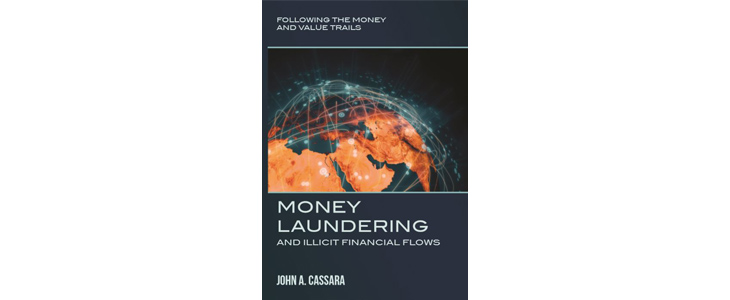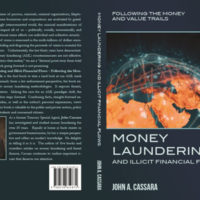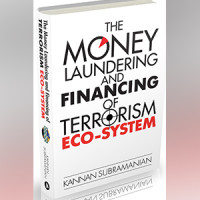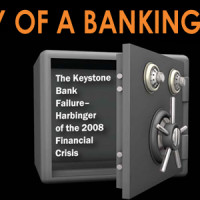
Former Special Agent of the U.S. Department of Treasury's Office of Terrorism and Financial Intelligence John A. Cassara has chronicled his 30-plus years of experience in the fight against transnational organized crime and money laundering in his newly released book, Money Laundering and Illicit Financial Flows: Following the Money and Value Trails. This book is the fifth in a series Cassara has written on the topics of money laundering and counter-terrorist financing, providing a comprehensive view of money laundering methods, both old and new.
Through a law enforcement lens, Cassara provides a global perspective on the dominant threats associated with money laundering and global financial crime as well as a sobering assessment of the efficacy―or lack thereof―of global efforts thus far in the fight against global financial crime. He concludes that anti-money laundering (AML) measures to date have not been effective for a variety of reasons and that from a purely statistical point of view, the founding president of Global Financial Integrity states, “ total failure is just a decimal point away.”
For readers who are new to AML, this book covers not only the money laundering basics, but also a deep dive on key topics such as bulk cash smuggling, trade-based money laundering and alternative remittance systems, among others. Each chapter is followed by an extensive notes’ section that includes many other reference documents for readers who would like more information on these topics. Even for the seasoned AML professional, the book provides a thorough review of all the major AML typologies from the law enforcement perspective.
One of the most significant chapters in the book discusses the rising money laundering threat from a financially booming China. The chapter is a must read for all AML practitioners whether you are in law enforcement, a regulatory agency or the financial services industry. It describes multiple financial crime threats posed by China, including narcotics, counterfeit goods and intellectual property rights violations, human trafficking, corruption, wildlife trafficking, illegal logging, trade fraud, weapons proliferation, capital flight, predatory lending, strong-arm tactics and more.
While the author is generally critical of the lack of success of AML measures to date, he acknowledges that it is not for lack of trying and recognizes the talent and dedication of AML professionals he has encountered throughout his career. The final chapter of the book is a call to action and provides forward-looking steps and opportunities to enhance AML measures. Cassara affirms what most AML professionals already know: The national AML strategy needs to be reinvigorated and reimagined. He states, “we should keep what works but not be afraid to jettison countermeasures that aren’t working or that are not cost effective. Band-aids and tinkering around the edges are not going to give us the results we need. It is time for a radical AML paradigm shift.”
Among the recommendations that Cassara makes is for law enforcement to really go after the money. He admits that law enforcement has, in the past, primarily gone after the participants and the products, whether they are drugs, trafficked persons or weapons. While there has been talk about taking the proceeds out of crime, a focus on the money has generally not happened for a variety of reasons. Cassara discusses the need to change the incentives for law enforcement, which would mean a change in strategy from the top to reorient the priorities for investigators and their supervisors to focus on following the money and the seizure of illicit proceeds. There are also several recommendations that deal with the return of a variety of law enforcement agencies to the U.S. Treasury Department. Cassara feels that the mandate, expertise and data to pursue the missions of what had been the legacy Customs and Secret Service agencies were lost in the restructuring after the attacks on September 11. He believes that the investigation of money laundering, trade-based money laundering and value transfer diminished with the focus of Immigration and Customs Enforcement on immigration rather than financial crime investigations.
Cassara discusses the need for a change in the AML analytic paradigm. He points out that because each detection agent, especially financial institutions (FIs), is monitoring its own transactional activity, there is no opportunity to see a holistic picture of an illicit actor’s illegal activity that may span multiple products, FIs and be conducted by an illegal actor that controls multiple accounts in the name of multiple legal entities. He further highlights that the current suspicious activity reporting process, in addition to producing relevant leads for law enforcement, also includes massive amounts of defensive suspicious activity reports that clog up government systems with garbage data, making it more difficult for law enforcement to locate relevant information. Cassara recognizes the effort and expenditure that FIs have made in their transaction monitoring (TM) and reporting efforts but opines that it is not working. He points out that “Einstein reportedly defined ‘insanity’ as doing the same thing over and over again expecting a different result.” Could this be a reference to legacy TM systems? He highlights that one of the biggest opportunities to create a new AML and counter-terrorist financing paradigm would be to leverage digitalized data, high-speed processing and advanced analytics. New technology and analytical capabilities also present fresh opportunities for a public-private sector partnership in financial intelligence, and a potential opportunity for a consortium facility that would operate as a monitoring function for the collective transactions of the participants that are anonymized to preserve customer privacy. Cassara points out that initiatives like these could act to shift the paradigm from identification of illicit activity after the fact to more of a preventive model with more real-time identification of suspicious activity.
In the realm of enforcement, Cassara also underscores his belief that individuals should be held accountable for corporate wrongdoing in order to deter crime. While the priority to hold individuals accountable has been used in a few cases, it is generally the compliance officer that gets shot. Cassara would like to see the criminals in the management suites be held accountable like the criminals in the streets.
Among the author’s final thoughts are that the mission of curtailing transnational crime, international money laundering and illicit financial flows is never accomplished, but the gravity of the situation is too important to ever give up. As he says, “the flip side of failure is opportunity.” The book ends on that optimistic note.
Money Laundering and Illicit Financial Flows: Following the Money and Value Trails is available for purchase on Amazon.










